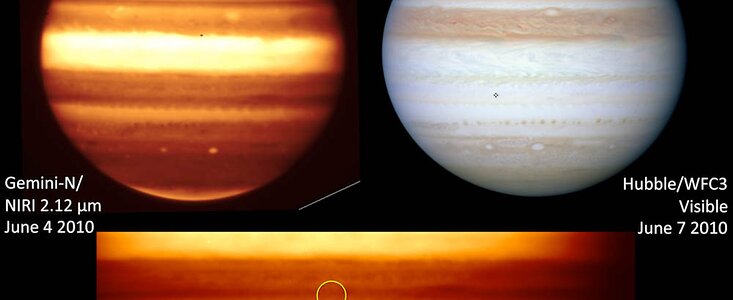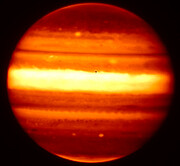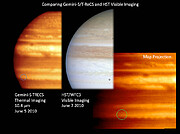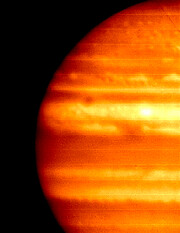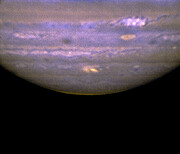Without A Trace
A Flash In Jupiter's Sky
9 September 2010
Observing a fireball streaking through the atmosphere of another planet is a rare occurrence. However, two amateur astronomers did just that on June 3, 2010. Their images prompted the twin Gemini Observatory telescopes in Hawai‘i and Chile to join other telescopes around (and above) the world to see if the object left any trace of its passage into Jupiter’s cloudtops.
Amateur astronomers Anthony Wesley in Australia and Christopher Go in the Philippines used high-speed, video-monitoring equipment to capture the fleeting event concurrently. Shortly thereafter, the world’s largest telescopes examined Jupiter for debris left behind. According to NASA's Jet Propulsion Laboratory's Glenn Orton from the team studying the data, "We made the case to Gemini and other observatories that even if we saw nothing, it was important to bound the lower-size limits of objects that could influence Jupiter's atmosphere."
Both Gemini telescopes looked for evidence of the event by observing in different parts of the infrared spectrum. Images from Gemini North’s Near-Infrared Imager (NIRI) are sensitive to debris in Jupiter’s upper atmosphere, and mid-infrared images from Gemini South’s Thermal-Region Camera and Spectrograph (T-ReCS) could show heating and chemical reactions in the atmosphere. However, like all of the follow-up observations, neither Gemini instrument detected any trace of the impact.
Unlike previous collisions with Jupiter, where large, dark scars appeared in its clouds for weeks (e.g. Shoemaker-Levy 9 (D/1993 F2), which hit in 1994), this event apparently vaporized entirely in Jupiter’s upper atmosphere without marring the planet. Nonetheless, as the analysis published in a paper today in The Astrophysical Journal Letters shows, the absence of any persistent signatures sets limits on the size and mass of the object.
The object that made the flash, called a superbolide, likely measured between 8-13 meters across, with a mass between 500-2000 metric tons (10 meters is the approximate height of a 3-story building, 1000 metric tons is approximately the mass of 150 school buses). Lead author of the paper, Ricardo Hueso of the Universidad del Pais Vasco, Bilbao, Spain, adds, “Bolides [striking] Jupiter are very difficult to find, since they emit an optical flash that last only a few seconds. One important aspect of the work is that now we have a door to investigate the number of small, 10-meter-sized objects in the outer Solar System.”
Several objects of this size probably impact Jupiter each year. “It is interesting to note that whereas Earth gets smacked by a 10-meter-sized object about every 10 years on average, it looks as though Jupiter gets hit with the same-sized object a few times each month,” said Don Yeomans, manager of the Near-Earth Object Program Office at NASA’s Jet Propulsion Laboratory, who was not involved in the paper. “The Jupiter impact rate is still being refined, and studies like this one help to do just that.”
The discoverers Wesley and Go are part of a community of amateur astronomers who diligently monitor planets in the Solar System for transient events like this one. According to Wesley, "More and more amateur astronomers are becoming involved in high-resolution imaging of Jupiter and Saturn, taking advantage of new technology to produce stunning images that are of great value to planetary researchers and enthusiasts everywhere. This last year has seen Jupiter monitored and imaged by amateurs more often than ever before, a trend that is certain to continue into the future." Wesley was also the first to spot a collision with Jupiter in 2009 that was observed by Gemini, see: http://www.gemini.edu/node/11300. Christopher Go is credited with discovering the temporary appearance of Jupiter’s “Red Spot Junior” in February 2006, which Gemini also observed, see: http://www.gemini.edu/node/196.
Contacts
Peter Michaud
Gemini Observatory
Hilo, HI 96720
Tel: 1 (808) 974-2510
Cell: 1(808) 936-6643
Email: pmichaud@gemini.edu
Glenn Orton
Jet Propulsion Laboratory
Tel: Desk: (818) 354-2460
Email: Glenn.orton@jpl.nasa.gov
About the Release
| Release No.: | gemini1009 |
| Name: | Jupiter |
| Facility: | Gemini North, Gemini South |
| Instruments: | NIRI, T-ReCS |
| Science data: | 2010ApJ...721L.129H |

